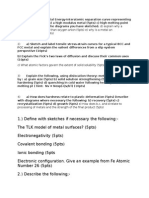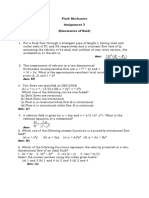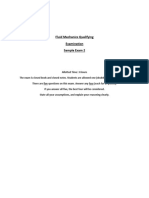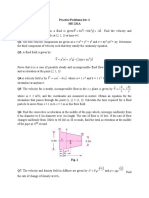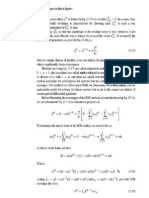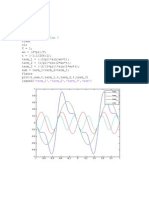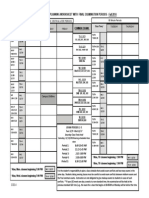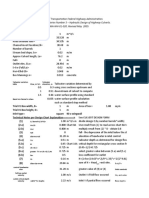0 ratings0% found this document useful (0 votes)
792 viewsMEC 364 - Homework 7
MEC 364 - Homework 7
Uploaded by
Elianne GabbayThis homework assignment on fluid mechanics contains 9 problems involving calculating velocities, accelerations, and other properties of various incompressible fluid flows. Students are instructed to show their work in detail to receive credit. The problems cover topics such as calculating acceleration of fluid particles in different velocity fields, determining if a given flow field represents possible incompressible flow, deriving expressions for radial velocity and acceleration in a narrow gap, and evaluating circulation and vorticity for various flows.
Copyright:
© All Rights Reserved
Available Formats
Download as PDF, TXT or read online from Scribd
MEC 364 - Homework 7
MEC 364 - Homework 7
Uploaded by
Elianne Gabbay0 ratings0% found this document useful (0 votes)
792 views1 pageThis homework assignment on fluid mechanics contains 9 problems involving calculating velocities, accelerations, and other properties of various incompressible fluid flows. Students are instructed to show their work in detail to receive credit. The problems cover topics such as calculating acceleration of fluid particles in different velocity fields, determining if a given flow field represents possible incompressible flow, deriving expressions for radial velocity and acceleration in a narrow gap, and evaluating circulation and vorticity for various flows.
Original Description:
Fluids
Copyright
© © All Rights Reserved
Available Formats
PDF, TXT or read online from Scribd
Share this document
Did you find this document useful?
Is this content inappropriate?
This homework assignment on fluid mechanics contains 9 problems involving calculating velocities, accelerations, and other properties of various incompressible fluid flows. Students are instructed to show their work in detail to receive credit. The problems cover topics such as calculating acceleration of fluid particles in different velocity fields, determining if a given flow field represents possible incompressible flow, deriving expressions for radial velocity and acceleration in a narrow gap, and evaluating circulation and vorticity for various flows.
Copyright:
© All Rights Reserved
Available Formats
Download as PDF, TXT or read online from Scribd
Download as pdf or txt
0 ratings0% found this document useful (0 votes)
792 views1 pageMEC 364 - Homework 7
MEC 364 - Homework 7
Uploaded by
Elianne GabbayThis homework assignment on fluid mechanics contains 9 problems involving calculating velocities, accelerations, and other properties of various incompressible fluid flows. Students are instructed to show their work in detail to receive credit. The problems cover topics such as calculating acceleration of fluid particles in different velocity fields, determining if a given flow field represents possible incompressible flow, deriving expressions for radial velocity and acceleration in a narrow gap, and evaluating circulation and vorticity for various flows.
Copyright:
© All Rights Reserved
Available Formats
Download as PDF, TXT or read online from Scribd
Download as pdf or txt
You are on page 1of 1
MEC 364: Homework #7
Due date: 11/15/12
Note: this homework counts double.
To receive credit for a problem you must show your work in great detail
1. Consider the velocity field V = Axyi - (1/2)Ay2j in the xy-plane, where A = 0.25 m-1s-1, and the coordinates are
measured in meters. Is this a possible incompressible flow field? Calculate the acceleration of a fluid particle at
point (x, y) = (2, 1). ANS: a = (0.0625i+ 0.03125j) m/s2.
2. The variation in cross-sectional area with distance along a diffuser may be expressed as A = A1eax, where A1 is
the cross-sectional area at the diffuser inlet. Assume that the flow is incompressible and uniform at any cross
section. Sketch the variations of the area and velocity along the diffuser as functions of x. Develop an algebraic
expression for the acceleration of a fluid particle in the diffuser in terms of V1 and x. ANS: ax = -a(V1)2e-2ax.
3. Incompressible liquid of negligible viscosity is pumped at total volume flow rate Q through two small holes
into the narrow gap between closely spaced circular parallel plates. The spacing between the plates is h. The
liquid flowing away from the holes has only radial motion. Assume uniform flow across any vertical section and
discharge to atmospheric pressure at r = R. (a) show that the radial velocity in the narrow gap is Vr = Q/(2rh).
(b) Derive an expression for the acceleration of a fluid particle in the gap. ANS: a = -[Q/(2h)]2(1/r3)er.
4. A steady, two-dimensional velocity field is given by V = Axi Ayj, where A = 1 s-1. Show that the streamlines
for this flow are rectangular hyperbolas, xy = C. Plot streamlines that correspond to C = 0, 1, and 2 m2. Obtain a
general expression for the acceleration of a fluid particle in this velocity field. Calculate the acceleration of fluid
particles at the points (x, y) = (0.5, 2), (1, 1), and (2, 0.5), where x and y are measured in meters. Show the acceleration vectors on the streamline plot. ANS: a = (0.5i + 2j) m/s2; a = (i + j) m/s2, a = (2i + 0.5j) m/s2.
5. A velocity field is represented by the expression V = (Ax B)i + Cyj + Dtk, where A = 2 s-1, B = 4 m s-1, and D
= 5 m s-2. Determine the proper value for C if the flow field is to be incompressible. Calculate the acceleration
of a fluid particle located at the point (x, y) = (3, 2). Sketch the flow streamlines in the xy-plane. ANS: C = -2 s-1,
a = (4i + 8j + 5k) m/s2.
6. A flow is represented by the velocity field V = 10xi 10yj +30k. Determine if the flow field is (a) a possible
incompressible flow, and (b) irrotational.
7. Consider the two-dimensional incompressible flow field in which u = Axy and v = By2, where A = 1 m-1s-1 and
B = -0.5 m-1s-1. Determine the rotation at point (x, y) = (1,1). Evaluate the circulation about the curve bounded
by y = 0, x = 1, y =1, and x = 0. ANS: w = -0.5k rad s-1, = -0.5 m2 s-1.
8. Consider the pressure-driven flow between stationary parallel plates separated by distance b. Coordinate y is
measured from the bottom plate. The velocity field is given by u = U(y/b)[1-(y/b)]. Obtain an expression for the
circulation about a closed curve of height h and length L. Evaluate when h = b/2 and when h = b. Show that the
same result is obtained from the area integral of the Stokes theorem (Eq. 5.18 in reference book by Fox et al.).
ANS: h = b/2 = -UL/4, h = b = 0.
9. Consider the pressure-driven flow between stationary parallel plates separated by distance 2b. Coordinate y is
measured from the channel centerline. The velocity field is given u = umax[1-(y/b)2]. Evaluate the rate of linear
and angular deformation. Obtain an expression for the vorticity vector . Find the location where the vorticity is
maximal. ANS: (d/dt) = -2umaxy/b2, = 2umaxy/b2k.
[Notation: Bold represents a vector quantity]
You might also like
- Fluid Mechanics With Engineering Applications by E.john Finnemore and Joseph B.franzini (10th Edition) - Allpdf - inDocument621 pagesFluid Mechanics With Engineering Applications by E.john Finnemore and Joseph B.franzini (10th Edition) - Allpdf - inEZ LearningNo ratings yet
- ESG 332 Practice Exam 1Document2 pagesESG 332 Practice Exam 1Elianne Gabbay0% (2)
- Kathmandu University: Department of Mechanical EngineeringDocument2 pagesKathmandu University: Department of Mechanical Engineeringabdata wakjiraNo ratings yet
- Practise Problem (Exercise - 1)Document2 pagesPractise Problem (Exercise - 1)Deepak Kumar SinghNo ratings yet
- Tutorial 4 - Fluid KinematicsDocument3 pagesTutorial 4 - Fluid KinematicsAnson Nai0% (1)
- Jejejeje Lo HiceDocument37 pagesJejejeje Lo HiceGank Sfk100% (2)
- Worksheet FlowDocument18 pagesWorksheet FlowRaymond VoongNo ratings yet
- AP Physics Question BankDocument99 pagesAP Physics Question BankElianne Gabbay100% (2)
- FT5Document3 pagesFT5workwithnormalguyNo ratings yet
- Lecture 5Document46 pagesLecture 5ζοβαγεπ ἯοΣΣαῖηNo ratings yet
- ME 231 Assignment 3Document4 pagesME 231 Assignment 3tjeeadvanceNo ratings yet
- Sheet 02 20-21 Kinematics of FluidDocument1 pageSheet 02 20-21 Kinematics of FluidAvishek BiswasNo ratings yet
- Tutorial Chapter 4Document3 pagesTutorial Chapter 4Lim Yi ZhuangNo ratings yet
- Fluid Mechanics Assignment 2Document3 pagesFluid Mechanics Assignment 2AbcdeNo ratings yet
- Fluid Mechanics Assignment 3 (Kinematics of Fluid) : DX Dy X yDocument2 pagesFluid Mechanics Assignment 3 (Kinematics of Fluid) : DX Dy X ypawan sharmaNo ratings yet
- Study Set 1Document8 pagesStudy Set 1anteljohnNo ratings yet
- FM Module 3 ProbsDocument7 pagesFM Module 3 Probsyogesh shindeNo ratings yet
- Soal Tutorial 3 Ms2231 2016Document1 pageSoal Tutorial 3 Ms2231 2016Arnold GiovanniNo ratings yet
- Lecture 5 TutorialDocument2 pagesLecture 5 TutorialFarez IzwanNo ratings yet
- Assignment - 1 - ClassDocument9 pagesAssignment - 1 - ClassMayand MalikNo ratings yet
- FM Module 3 ProbsDocument11 pagesFM Module 3 Probsyogesh shinde100% (1)
- Homework 6Document4 pagesHomework 6mikeryuuNo ratings yet
- Tutorial and Practice ProblemsDocument2 pagesTutorial and Practice ProblemsPranshul SesmaNo ratings yet
- Ce 371 Homework 5Document2 pagesCe 371 Homework 5HenryNielsenNo ratings yet
- SCI, Mekanik, KTH 1Document11 pagesSCI, Mekanik, KTH 1張祐瑜No ratings yet
- Mae3241 HW2Document2 pagesMae3241 HW2Luiz Fernando T. Vargas100% (1)
- Fluid Mechanics Sample Exam 2Document6 pagesFluid Mechanics Sample Exam 2Muhammed YagciogluNo ratings yet
- Solution For Chapter 4 Differential FlowDocument24 pagesSolution For Chapter 4 Differential Flowkombat13_708353334100% (3)
- Potential Flow Tutorial - Jan-Feb 2013Document2 pagesPotential Flow Tutorial - Jan-Feb 2013Abigael R. FortadesNo ratings yet
- Practice Problem Set - II PDFDocument3 pagesPractice Problem Set - II PDFMukul ChandraNo ratings yet
- Assignment 2Document2 pagesAssignment 2Vikrant SinghNo ratings yet
- Flow ExercisesDocument40 pagesFlow ExercisesManon VerhoevenNo ratings yet
- Fluid Mechanics Assignment 3 Kinematics: Aditya BandopadhyayDocument2 pagesFluid Mechanics Assignment 3 Kinematics: Aditya BandopadhyayGunda Venkata SaiNo ratings yet
- IntroductionDocument2 pagesIntroductionfredNo ratings yet
- EML 3701 Homework Assignment 4Document3 pagesEML 3701 Homework Assignment 4AlexanderZajdaNo ratings yet
- Exam in Fluid Mechanics 5C1214Document3 pagesExam in Fluid Mechanics 5C1214alialavi2No ratings yet
- Fluid Mechanics Sample Exam 3Document6 pagesFluid Mechanics Sample Exam 3Muhammed YagciogluNo ratings yet
- Gasdynamics 2023 2024 Task1Document13 pagesGasdynamics 2023 2024 Task1sanj2498No ratings yet
- Aerodynamics Tutorial IistDocument2 pagesAerodynamics Tutorial IistShubham MauryaNo ratings yet
- StreamDocument8 pagesStreamsh578453No ratings yet
- Soal Uas Mekanika FluidaDocument2 pagesSoal Uas Mekanika FluidaMira SyafanurillahNo ratings yet
- 0910sem2 Me2135Document6 pages0910sem2 Me2135brugelionNo ratings yet
- Sheet (1) Fluid Kinematics PDFDocument3 pagesSheet (1) Fluid Kinematics PDFABDELRHMAN ALINo ratings yet
- Tutorial Potential FlowDocument3 pagesTutorial Potential FlowAfrina daniaNo ratings yet
- Homework 5Document3 pagesHomework 5vassaNo ratings yet
- Tutorial N°2 Fluid MechanicsDocument2 pagesTutorial N°2 Fluid MechanicsNCHE BORISNo ratings yet
- Problems KinematicsDocument3 pagesProblems KinematicsAsjad khanNo ratings yet
- Homework1 13Document2 pagesHomework1 13alialavi2No ratings yet
- U in The Positive X: CL203, Autumn 2009Document16 pagesU in The Positive X: CL203, Autumn 2009RohanKumarNo ratings yet
- Mec2910-Final Exam Sem I 08-09Document6 pagesMec2910-Final Exam Sem I 08-09sh1999No ratings yet
- Fluid Mechanics Assignment-6Document1 pageFluid Mechanics Assignment-6Suryansh KumarNo ratings yet
- Flow in Intake ManifoldDocument6 pagesFlow in Intake ManifoldShailendra SinghNo ratings yet
- SPC 307 Sheet-4Document7 pagesSPC 307 Sheet-4Ercan Umut DanışanNo ratings yet
- MT335 Chap3 Fluid Flow - ExamplesDocument17 pagesMT335 Chap3 Fluid Flow - ExamplesẄâQâŗÂlï100% (1)
- AER 504 Aerodynamics: Ryerson University Department of Aerospace EngineeringDocument8 pagesAER 504 Aerodynamics: Ryerson University Department of Aerospace EngineeringbatmanbittuNo ratings yet
- Work Sheet and Assignment IIDocument11 pagesWork Sheet and Assignment IIAb AnNo ratings yet
- PCB3013-Well Test Analysis HW# 8 Prof. Dr. Mustafa Onur, UTP, September 2013Document3 pagesPCB3013-Well Test Analysis HW# 8 Prof. Dr. Mustafa Onur, UTP, September 2013Chai CwsNo ratings yet
- Phys245 Notes PDFDocument117 pagesPhys245 Notes PDFfuckitNo ratings yet
- Assignment 1Document3 pagesAssignment 1Ssheshan PugazhendhiNo ratings yet
- Student Solutions Manual to Accompany Economic Dynamics in Discrete Time, second editionFrom EverandStudent Solutions Manual to Accompany Economic Dynamics in Discrete Time, second editionRating: 4.5 out of 5 stars4.5/5 (2)
- Jacobi and Gauss-SeidelDocument1 pageJacobi and Gauss-SeidelElianne GabbayNo ratings yet
- Mec 214 HW1Document2 pagesMec 214 HW1Elianne GabbayNo ratings yet
- MEC 320 Homework 9Document1 pageMEC 320 Homework 9Elianne GabbayNo ratings yet
- Program Planning Worksheet With Final Examination Periods - Fall 2014Document1 pageProgram Planning Worksheet With Final Examination Periods - Fall 2014Elianne GabbayNo ratings yet
- WedmDocument1 pageWedmElianne GabbayNo ratings yet
- InterpolationDocument7 pagesInterpolationElianne GabbayNo ratings yet
- FM Module 3 ProbsDocument7 pagesFM Module 3 Probsyogesh shindeNo ratings yet
- What Are ARV or ARC Valves? When To Use Automatic Recirculation Valve?Document4 pagesWhat Are ARV or ARC Valves? When To Use Automatic Recirculation Valve?ÅdnAn MehmOodNo ratings yet
- Advanced Fluid Mechanics PartDocument9 pagesAdvanced Fluid Mechanics PartkishorebabubhumulaNo ratings yet
- Section 7 - Separation EquipmentDocument9 pagesSection 7 - Separation Equipmentlulis171No ratings yet
- Fundamentals of Reservoir Oil Flows AnalysisDocument31 pagesFundamentals of Reservoir Oil Flows AnalysisMohamed AoudiNo ratings yet
- Culvert WorksheetDocument6 pagesCulvert WorksheetBakti NusantaraNo ratings yet
- KG Per HR To MMSCFD & BBL Into m3phDocument6 pagesKG Per HR To MMSCFD & BBL Into m3phsathishNo ratings yet
- DB 01.01.02.10 Pump M8Document3 pagesDB 01.01.02.10 Pump M8Pramod KumarNo ratings yet
- Fluid Mechanics PDFDocument192 pagesFluid Mechanics PDFLawNo ratings yet
- CE 023 4 Buoyancy and StabilityDocument34 pagesCE 023 4 Buoyancy and StabilityANGELA BALAISNo ratings yet
- 4 BuoyancyDocument5 pages4 BuoyancyDaniel Vasquez0% (1)
- MI 205 Luid Mechanics: B. K. GandhiDocument28 pagesMI 205 Luid Mechanics: B. K. GandhiAshutosh SinghNo ratings yet
- Water HammerDocument18 pagesWater Hammersaishankarl100% (2)
- Modelling Urban Pollution Dispersion by Using MISKAMDocument7 pagesModelling Urban Pollution Dispersion by Using MISKAMMárton BalczóNo ratings yet
- Onera S1maDocument29 pagesOnera S1maSindbad SailorNo ratings yet
- Pipe SurgeDocument9 pagesPipe SurgeMark Raphael KipkiruiNo ratings yet
- CHAPTER 4 - UNIFORM OPEN CHANNEL FLOW - Sesi 1Document37 pagesCHAPTER 4 - UNIFORM OPEN CHANNEL FLOW - Sesi 1mohd irfanNo ratings yet
- Fluid Mechanics Tutorial 8C Pumped Piped Systems: Let's Start by Examining The Meaning of Specific Speed of PumpsDocument17 pagesFluid Mechanics Tutorial 8C Pumped Piped Systems: Let's Start by Examining The Meaning of Specific Speed of Pumps12No ratings yet
- 2.60 SP Series-MinDocument23 pages2.60 SP Series-MinKikuchi ToumaNo ratings yet
- CE 336 Lab #7Document11 pagesCE 336 Lab #7husseinfarhatmNo ratings yet
- Stalagmometer - KRÜSS ScientificDocument3 pagesStalagmometer - KRÜSS ScientificRamirez FrancisNo ratings yet
- Mechatronics EngineeringDocument128 pagesMechatronics EngineeringAkarsh ManojNo ratings yet
- Venturi Injector With Rotameter: Benefits of Rotameter SpecificationsDocument1 pageVenturi Injector With Rotameter: Benefits of Rotameter SpecificationsRajat GuptaNo ratings yet
- FMC Max Recommended Flow Rates For Swivels & PupsDocument1 pageFMC Max Recommended Flow Rates For Swivels & Pupspaulegi5No ratings yet
- Abtract Navier-Stokes EquationsDocument2 pagesAbtract Navier-Stokes EquationsAnderson Steven Peña SabogalNo ratings yet
- Scientific Devices CatalogDocument9 pagesScientific Devices Catalogharivishal.otomatiksNo ratings yet
- Pump ADocument172 pagesPump AAdithya VKNo ratings yet
- Simpack Wind 2010 Swe LoadsimulationsDocument26 pagesSimpack Wind 2010 Swe LoadsimulationsRamon Gutierrez100% (1)

